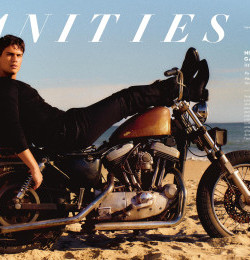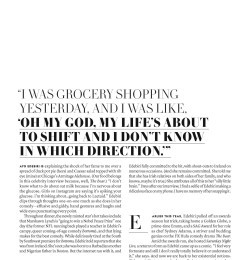Vanity Fair USA


Each issue delivers high-profile interviews, stunning photography, and thought-provoking features on the world's most engaging, people, places, and personalities. Your subscription includes must-see special issues like the Hollywood issue and the Music issue, and monthly coverage of the movers and shakers in entertainment, media, politics, business and the arts.
Vanity Fair is an American magazine of pop culture, fashion, and politics published by Condé Nast Publications. The present Vanity Fair has been published since 1981 and there have been editions for four European countries as well as the U.S. edition. This revived the title which had ceased publication in 1935 after a run from 1913; the worldwide depression had reduced sales dramatically by then.
Condé Nast began his empire by purchasing the men's fashion magazine Dress in 1913. He renamed the magazine Dress and Vanity Fair and published four issues in 1913. He is said to have paid $3,000 for the right to use the title "Vanity Fair" in the United States, but it is unknown whether the right was granted by an earlier English publication or some other source. It was almost certainly the magazine "The Standard and Vanity Fair", "the only periodical printed for the playgoer and player", published weekly by the "Standard and Vanity Fair Company, Inc", whose president was Harry Mountford, also General Director of The White Rats theatrical union. After a short period of inactivity the magazine was relaunched in 1914 as Vanity Fair.
The magazine achieved great popularity under editor Frank Crowninshield. In 1919 Robert Benchley was tapped to become managing editor. He joined Dorothy Parker, who had come to the magazine from Vogue, and was the staff drama critic. Benchley hired future playwright Robert E. Sherwood, who had recently returned from World War I. The trio were among the original members of the Algonquin Round Table, which met at the Algonquin Hotel, on the same West 44th Street block as Condé Nast's offices.
Crowninshield attracted the best writers of the era. Aldous Huxley, T. S. Eliot, Ferenc Molnár, Gertrude Stein, and Djuna Barnes all appeared in a single issue, July 1923.
Starting in 1925 Vanity Fair competed with The New Yorker as the American establishment's top culture chronicle. It contained writing by Thomas Wolfe, T. S. Eliot and P. G. Wodehouse, theatre criticisms by Dorothy Parker, and photographs by Edward Steichen; Claire Boothe Luce was its editor for some time.
In 1915 it published more pages of advertisements than any other U.S. magazine. It continued to thrive into the twenties. However, it became a casualty of the Great Depression and declining advertising revenues, although its circulation, at 90,000 copies, was at its peak. Condé Nast announced in December 1935 that Vanity Fair would be folded into Vogue (circulation 156,000) as of the March 1936 issue.
Condé Nast Publications, under the ownership of Si Newhouse, announced in June 1981 that it was reviving the magazine. The first issue was published in February 1983 (cover date March), edited by Richard Locke, formerly of The New York Times Book Review. After three issues, Locke was replaced by Leo Lerman, veteran features editor of Vogue. He was followed by editors Tina Brown (1984–1992) and E. Graydon Carter (since 1992). Regular columnists include Sebastian Junger, Michael Wolff, Christopher Hitchens, the late Dominick Dunne, Vicky Ward, and Maureen Orth. Famous contributing photographers for the magazine include Bruce Weber, Annie Leibovitz, Mario Testino and the late Herb Ritts, all who have provided the magazine with a string of lavish covers and full-page portraits of current celebrities. Amongst the most famous of these was the August 1991 Leibovitz cover featuring a naked, pregnant Demi Moore, an image entitled More Demi Moore that to this day holds a spot in pop culture.
In addition to its controversial photography, the magazine also prints articles on a variety of topics. In 1996, journalist Marie Brenner wrote an exposé on the tobacco industry entitled "The Man Who Knew Too Much". The article was later adapted into a movie The Insider (1999), which starred Al Pacino and Russell Crowe. Most famously, after more than thirty years of mystery, an article in the May 2005 edition revealed the identity of Deep Throat (W. Mark Felt), one of the sources for The Washington Post articles on Watergate, which led to the 1974 resignation of U.S. President Richard Nixon. The magazine also includes candid interviews from celebrities: from Teri Hatcher admitting to being abused as a child to Jennifer Aniston's first interview after her divorce from Brad Pitt. Anderson Cooper talked about his brother's death while Martha Stewart gave an exclusive to the magazine right after her release from prison.
In August 2006, Vanity Fair sent photographer Annie Leibovitz to the Telluride, Colorado home of Tom Cruise and Katie Holmes for its October 2006 issue. The photo shoot was of the couple and their daughter, Suri Cruise, who had previously been "hidden", without pictures released to the public, causing many to start to deny her existence. This issue became the second highest selling issue for the magazine; the first was the Jennifer Aniston cover after her divorce.
In keeping with the influence of Hollywood and pop culture on the magazine, Vanity Fair hosts a high-profile, exclusive Academy Awards after-party at the restaurant Morton's. In addition, its annual Hollywood issue usually consists of pictorials of that year's respective Academy Award nominees. Previous Hollywood issue covers have included group images of Gwyneth Paltrow, Nicole Kidman, and Catherine Deneuve together and Owen Wilson, Ben Stiller, Chris Rock, and Jack Black together.
The magazine was the subject of Toby Young's book, How to Lose Friends and Alienate People, about his search for success, from 1995, in New York working for Graydon Carter's Vanity Fair. The book has been made into a movie, with Jeff Bridges playing Carter.
There are currently three international editions of Vanity Fair being published, namely in the United Kingdom (started 1991), Spain and Italy, with the Italian version published weekly. The German edition was shut down in 2009.





